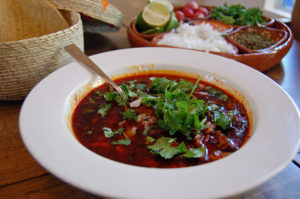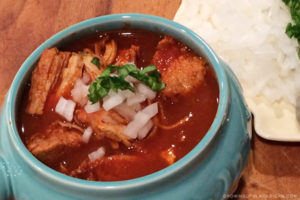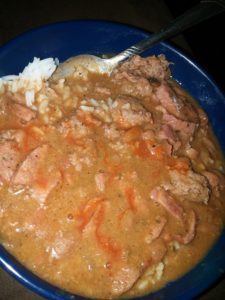Personal Experience to the Dish (Birria): Before I tell this recipe, I think it is important that I give you all my personal history with this dish. When I first moved with my biological mom, I was introduced to so many Mexican dishes. Like most people who are not familiar with Mexican culture, I had only known of tacos, burritos, and quesadillas. I was not allowed to eat Mexican food when I was younger because my adopted mother hated it and did not allow it in the house. But, when I moved with my biological mother I was able to indulge in so many dishes. I was introduced to a new dish every day. My mom and her boyfriend were food critics. We would eat out three times a day. In the morning we would eat simple breakfast food from ihop, Denny’s or someplace similar. For lunch we would eat Mexican food and for dinner my mom’s boyfriend would take us to a fancy dinner. This was our daily routine. Although I enjoyed all the meals very much, my favorite was always lunch because I had acquired this immensely strong love for Mexican food. That said, when I tied birria for the first time that love turned into an addiction. My neighbors were the people who told my mom about the place with the birria. They worked in the store at one point and had known the owners very well. When we first arrived at the place, it was a hole in the wall store. I remember asking my mom if she had gotten the right address. When we actually stepped into the store it was very empty. It reminded me of those archetypical gas stations in a nearly desolate town that you see in movies. It was scarcely supplied and had random items sporadically placed on the shelves. There was one of everything. One pack of razors, one pack of pads, one toothbrush, one pack of assorted chips. It was extremely strange, yet I was intrigued to know how this place sustained its business with such unreliable and inadequate inventory. In the center of the store there were about six tables arranged into two rows. There was nothing on the tables- I would have expected hot sauce, napkins, or eating utensils at least. It was kind of funny because my mom looked just as bewildered as me. She broke her silence by asking someone where to order birria. We were directed to the back of the store, near the sinks where they would wash their dishes. I recall there not being a tasty smell in the place. It was just hot and stuffy. I sat down while my mom ordered the food. She came back with a small cup of oil chile. At the time I thought nothing much of it- but it would soon be the beginning of a tedious journey for my mom trying to recreate the recipe. About ten minutes later the cashier arrived with our food. It smelled amazing! I could not wait to start eating. The birria was served with oil chile, cilantro, limes, minced onions and really thick fresh homemade tortillas. Around this time, I was pretty new to Mexican dishes, so I followed everything my mom did. She added a lot of onions, a small amount of cilantro and about three tablespoons of chile. She then rolled up a tortilla and dipped it in the birria. She bit into the tortilla after eating a spoonful of meat. Her eyes lit up! She paused and said “Oh my god, I have never in my life tasted birria better than this. How do they make this chilito?!” It was my turn to try now. I took my first bite and was amazed as well. I could not believe such a simple looking dish could taste so amazing. And of course she was right about the chilito. While I initially only added 3 tablespoons, I quickly realized that I needed much more. It was addicting! We sat there amazed while eating. Every Saturday after that day, my mom woke up early just to make sure she could get a large bowl of birria. One day she came home with nearly a liter of their chilito. She would add it to just about everything she cooked so it ran out very fast. It was the finishing touch to dishes like her fried shrimp tacos, fried potato tacos, menudo or even chicken tostadas. Birria became one of my top five favorite dishes (but only when it is cooked good, I have had some really terrible birria). My mom became obsessed with recreating the whole dish, but she focused on the chilito first because it was the ingredient that made the birria what it was. After she perfected the chilito, the birria came naturally. Today, I cannot tell the difference between her birria and the store’s birria. It is a dish she loves making and is quite proud of.

Photo Credit Masa Assassin
I went to Mexico for the first time in June of this year. I thought it was only right that I tried birria. I was expecting so much from the birria because I was in Mexico. However, I was sadly let down. I ordered tacos and birria. The tacos were good, but overwhelmed with mediocre guacamole. The barrio was good because it tasted similar to my mom’s recipe but not as good. The meat in the stew was very fatty and it was a tad bit bland. As for the chilito, it was like any other chile. There was nothing special about the birria. I knew it was not that great because I did not see that light in my mom’s eyes. We did not complain in front of my auntie and uncle about the food because it was actually good, but we could not help but compare it to my mom’s dish. When me and my mom finally got alone we did agree that she made it better. To this day, my mom (and the store) makes the best birria ever. I recently read an article that explained that LA is home to the most diverse adaptations of birria. It is becoming a very famous dish out here and with good reason. I would recommend this dish to anyone because I know they would love it. Since there are so many variations to the recipe, it can be altered for people who have specific meat preferences.

Photo Credit Masa Assassin
Chile Marinade
- 5 Pounds of beef.
- 12 Dried Guajillo chiles, seeded and deveined.
- 6 Garlic gloves (unpeeled).
- 2 Teaspoons of lightly toasted sesame seeds.
- 1/4 teaspoon of whole cloves.
- 3 tablespoons of cider vinegar.
- 1/4 Teaspoon of ground cumin.
- 1/2 Teaspoon of black peppercorns (3/4 teaspoon ground).
- 1 Teaspoon of salt.
- 2 Teaspoons of sugar.
Broth
- 1 (15 ounce) can of diced tomatoes (drained).
- 1 Teaspoon of fried oregano.
- 1/2 Teaspoon of salt.
- 2 Bay leaves.
- I Dash of ground cinnamon.
To Serve
- Warm corn tortillas.
- 1 Medium onion (finely chopped).
- 2 Tablespoons of dried Mexican oregano.
- 2 Fresh limes (cut into wedges).
Prep time: 24 hours Cook time: 2 hours Ready in: 26 hours
Tip: Aluminum foil helps keep food moist, ensures it cooks evenly, keeps leftovers fresh, and makes clean-up easy.

Photo Credit RubyDW
Steps for preparation:
PREPARE THE MEAT: Trim the fat from the meat; cut into 2 large pieces. Put meat into a large non-corrosive baking dish or pan.
PREPARE THE MARINADE/GLAZE: Heat a griddle or large cast-iron skillet over medium heat. Tear chiles into flat pieces and toast a few at a time, pressing them against the hot surface, until they crack and blister; flip them and press down again. Transfer chiles to a large bowl and cover with boiling water; weight down with a plate to keep them submerged, and soak at least 30 minutes. Meanwhile, roast the garlic in the same griddle or skillet, turning frequently, until soft inside and blackened outside, about 15 minutes. Cool and peel. Drain chiles, reserving 3/4 cup soaking liquid; put chiles into a blender with garlic, cloves, sesame seeds, vinegar, cumin, peppercorns or ground pepper, and salt. Process/blend until mixture is smooth; then strain through a medium-mesh sieve into a bowl. Remove 1/2 cup of mixture to a small bowl, and stir in the sugar; set aside to use for the final glazing.
MARINATE THE MEAT: Spread the rest of the chile paste thoroughly over the meat. Cover completely and refrigerate at least 18 hours.
COOK (SLOW-STEAM) THE MEAT: Preheat the oven to 325 degrees. Use a deep wide roasting pan that has a tight lid. Put a roasting rack into the bottom of the pan (it must sit at least 1 inch above the bottom of the pan—if not, prop it up with custard cups, tin cans, etc.) Measure in 4 cups of water. Then lay the marinated meat onto the rack and spread any marinade remaining in the marinating pan or dish. Cut a double thickness of heavy-duty foil to cover the roasting pan; place the pan lid over, making sure the pan is covered as tightly as possible. Bake 4 hours.
FINISHING THE BROTH: Remove the pan lid and foil; carefully remove the tender meat to a platter. Take out the rack; spoon the fat off the broth with a ladle. Measure out the broth into a 1-quart container; add water to equal 1-quart liquid if necessary, and pour into a saucepan. Puree the tomato in a blender and add it to the broth along with the oregano and cinnamon. Cover; simmer over medium-low heat 45 minutes. Season with salt.
GLAZE THE MEAT: Heat oven to 375 degrees. Remove meat from the bones, keeping pieces of meat as large as possible; discard bones, gristle and excess fat. Set meat on a baking sheet; brush lightly with reserved chile paste glaze, and bake 10 minutes to set the glaze.
TO SERVE: Keep tortillas warm in a towel-covered basket. Serve the broth in a tureen. Present the meat on a large platter, or slice meat across the grain to serve it in deep plates, awash in the broth. Combine onion and coriander in a small bowl to pass with the lime at the table.

Photo Credit Masa Assassin
History of the Dish: I think it is important to expound on the actual history of this dish as well. Birria was originated in Jalisco. Interestingly, this spicy stew was originally made from mutton or goat meat. However, people occasionally made it from chicken or beef. Today, it is widely cooked with beef. This dish can be a little expensive and time consuming. Similar to tamales, birria is usually served for special occasions. It is imperative that birria is served with onions, cilantro and tortillas. Homemade tortillas are better than any other, especially for this particular dish. Today, the meat for birria is usually prepared in the oven then the stew is cooked on the stove-top. Places like Zacatecas, Jalisco and Aguascalientes use goat or lamb while other places use various meats. People from Jalisco and Guadalajara best associate with the dish and can culturally identity themselves with it. However, other places have developed their own adaptations to the famous dish.

Photo Credit Masa Assassin
References
Davin and Kennard. “Birria Recipe – Food.com.” Recipe – Food.com. N.p.,13 Aug. 2007. Web. 07 Dec. 2016.
Willers, P.M., and Allegra J. Lingo. “What Is Birria? 02.” WiseGEEK. Conjecture Corporation, 02 Nov. 2016. Web. 07 Dec. 2016.
“Coriander.” Wikipedia. Wikimedia Foundation, n.d. Web. 07 Dec. 2016.
“How to Mince, Dice and Chop Onions.” Start Cooking. Kathy Maister 25 Aug. 2008. Web. 07 Dec. 2016.
Facebook.com/thewoksoflife. “How to Make Chili Oil – The Woks of Life.” The Woks of Life. N.p., 10 Apr. 2016. Web. 07 Dec. 2016.
“Mexico.” Wikipedia. Wikimedia Foundation, n.d. Web. 07 Dec. 2016.
“Guajillo Chili.” Wikipedia. Wikimedia Foundation, n.d. Web. 07 Dec. 2016.
“HISTORY.” Birrieria Jalisco. Birrieria Jalisco, 18 May 2010. Web. 07 Dec. 2016.
History.com Staff. “Jalisco.” History.com. A&E Television Networks, 18 July 2009. Web. 07 Dec. 2016.
Jenn, and Amy Shurts. “Corn Tortillas Recipe.” Allrecipes. N.p., 18 Dec. 2003. Web. 07 Dec.2016.
Esparza, Bill. “Essential T: The State of Regional Birria in L.A.” Los Angeles Magazine. Street Gourmet LA, 24 Feb. 2015. Web. 07 Dec. 2016.


 I did my presentation on my mom’s delicious tamales. Her tamales are really important to me because they were the first meal me and my mom cooked together. I was adopted at the age of 5. When I turned 18, I moved back with my biological mother. Before moving with her, I had only had her tamales one time. At that moment, they were the best things I had ever tasted. When I moved back with her it was only right that they were the first meal I requested.
I did my presentation on my mom’s delicious tamales. Her tamales are really important to me because they were the first meal me and my mom cooked together. I was adopted at the age of 5. When I turned 18, I moved back with my biological mother. Before moving with her, I had only had her tamales one time. At that moment, they were the best things I had ever tasted. When I moved back with her it was only right that they were the first meal I requested.